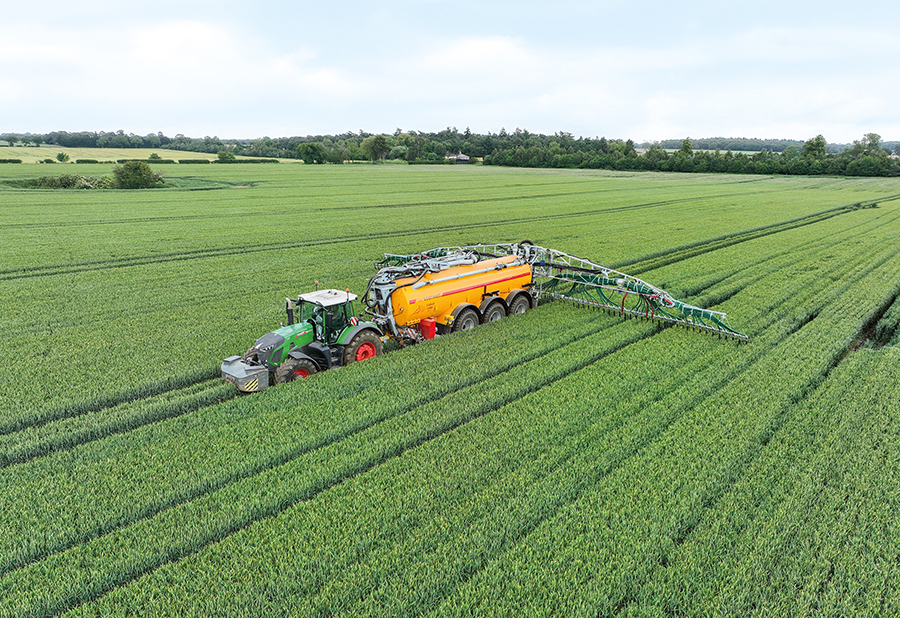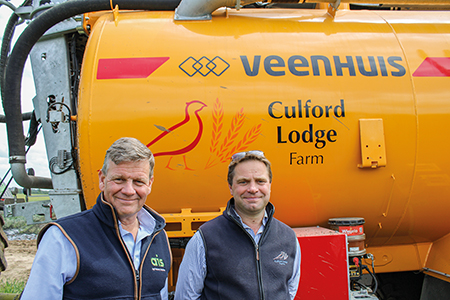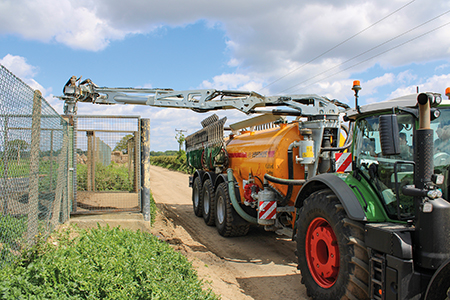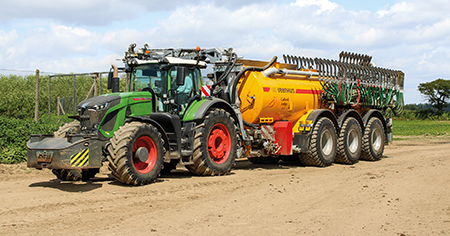Slurry tanker investment brings cost savings and environmental benefits
28th June 2024
Neale Byart visited a Suffolk farm recently to find out how farmer Oliver Stennet procured the perfect, future-proof slurry tanker for his family farm.

When arable farmer Oliver Stennet, a partner in Culford Lodge Farm, decided it was time to buy a new slurry tank, he already had a very good idea of what features and functions he wanted, along with the prerequisites of quality, reliability and durability – and was prepared to invest in the best possible option in order to meet these requirements.
Veenhuis had previously been on Oliver’s radar, so he approached Tim Merrell, director of Suffolk-based Veenhuis dealer, Agri Industry Solutions Ltd, to find out what the options were.
Working with the customer
“When Olly was looking to replace his tanker, he had been considering a Veenhuis for some time, so we went to Agritechnica in Germany with him,” Tim Merrell explains.
“At the show, we sat down in front of the Veenhuis big screen configurator while Olly put his ideal spec together, talking through his requirements with us as he went. This allowed us to produce the exact machine that Olly required, built specifically for him to meet all his needs.
“Veenhuis have been producing bespoke tanks for nearly 80 years, so there is almost nothing they haven’t previously been asked for.”

The slurry tank range consists of four versions, from the basic Ecoline to the Premiumline ranges, with multiple axle options and tank capacities up to 30,000 litres. Although the entry level models are a more affordable option, Veenhuis will not compromise on the features that it thinks are important; for example, the company has never offered a splashplate so, while other manufacturers are having to adapt their equipment to carry a dribble bar or injector, Veenhuis has been doing it for years, explains Tim.
“Some of the equipment that Veenhuis consider to be standard, is not always required in the UK – so the basic range allows them to ‘dumb down’ their offering to keep costs down where those features are not required. While Veenhuis products are top end, they work hard to give the customer not only a very durable and reliable machine, but also as bespoke a product as reasonably possible.”
The decision-making process
Oliver comments: “At Agritechnica, the build quality of the Veenhuis really stood out. I spent over two hours with the specialist rep on the stand, and the knowledge he had about the product, and his enthusiasm for the machine, was astonishing. This, along with speaking to an existing Veenhuis user, who had been running their tank for around eight trouble-free years, gave me the confidence in the longevity and reliability of the product.

“The problem we have is that the spreading window is so tight that we simply cannot afford any down time as we need to spread around 180,000 tonnes. The unit does also have a hard time on our tracks, so investing in top-end build quality for robustness was an easy choice. “What we really like, too, is the ability to upgrade software features and functions as and when they become available.”
Of course, getting things right can take time, and for Oliver this meant it took around two years to get exactly what he wanted, from design to delivery. “We went through the options several times to ensure we were getting a machine that would last us for at least 10 years and be as future-proof as possible,” he explains.
Fine-tuning the spec
“We really wanted a top loading arm, as that is what we are set up for and it works well for our lagoons,” Oliver told Farmers Guide. “We have around 1,000 hectares with no roads, and switch between running to field from the lagoon or being fed from tanks. This is the reason we chose a 30t machine over a 20t model.
“It is very quick to load, taking around six minutes from the lagoon and possibly slightly faster when loading from a tank.
For the application, Oliver chose a Vogelsang 24m dribble bar. “We considered the 36m option, but with all our other equipment being 24m, it would have cost a substantial amount in tanker and boom upgrades, so it made sense to stick at 24m. I was originally looking at a positive slot dribble bar, but realised it couldn’t be used in an up position and therefore could not spread from height, which we require for some of our operations.
“The Vogelsang dribble bar is a ’best of both worlds’ solution that allows us to slot inject (albeit not quite as aggressively), as well as spread from height.
“It is claimed that, especially on early spring crops, it gives better contact with the ground to reduce volatilisation. We also wanted to ensure it folded up for travel, but in such a way that it didn’t spill if we take it on the road.”
Double pump set-up
The double pump set-up brings various benefits. “It’s a completely sealed tank, and uses a vacuum pump to start the loading process, while the bulk is loaded using a centrifugal pump.
“The vacuum pump can also be used to purge the lines at the end of work. This is important with digestate, as on warm days it can dry in the lines and cause blockages if not cleared,” explains Oliver.
The centrifugal pump is also used for discharge, which Oliver reckons works much better than a vacuum pump on booms over 12m. As the vacuum pump is only used to start the initial filling process, and to clear lines at the end, the tank operates at a low enough pressure that it is exempt from pressure vessel testing.
Operator friendly
Although Oliver rarely uses the machinery himself, he is keen to ensure that his operators are happy with his choices. “We opted for full auto grease on the booms and the tank as, with around 60 grease points on the tank alone, it will save a lot of time.
“Veenhuis also runs hydraulic positive steering system with twin rams, one for each side, which is a big improvement over the cables on our previous tank that would get clogged with mud and delaminate or break, leaving us with steering issues. It takes a little more effort to initially set up, but once done we can just hook on and drop off in around 10 minutes, which means if we get an issue with one of our tractors, we can switch to the second very quickly.”
Range of spreading options

The farm uses different types of slurry and has different requirements for application density, Oliver explained: “This machine will spread down to around five tonnes per hectare, but we typically deliver in the region of 15–20 tonnes per hectare. Typical digestate analysis is around 3.5–4.5kg per tonne, so we deliver around 90kg per 20 tonne load, of which 80% is available to the crop. We can also use food waste, which allows us to run up to 250 tonnes per hectare when required. We store our own slurry on site which is typically produced from food waste and digestate.
“One of the features we looked at was the NIR sensor, which would give us real time data on slurry analysis. This would work well on the digestate, but the other products change regularly and are watery and weak, so we are not convinced it would give us a correct analysis. Instead, we send a sample into the lab for analysis every two or three weeks.”
Efficiency and environment
Overall, Oliver says he is very happy with his Veenhuis tanker and is an firm advocate for the benefits – both financial and environmental – it will continue to bring. “We have only had the Veenhuis on farm for around three weeks but have spread around 7,000 tonnes in that time. Before that we were using a Samson PG25 that we bought second hand and ran for around 10 years, so it was overdue for replacement.
“While it was a significant investment, the Veenhuis was purchased to reduce our usage of bagged fertiliser, and if we can reduce the amount of ammonium nitrates, ammonium sulphate and urea we buy the machine will, in effect, pay for itself in five or six years. This year, we are looking at buying only around 60 tonnes of bagged fertiliser for our 1,000 hectares. Obviously, there’s also an environmental benefit of reduced bagged fertiliser use too, making our operation much more sustainable,” Oliver concludes.
Visit the Agri Industry Solutions website for more information
Read more machinery news
